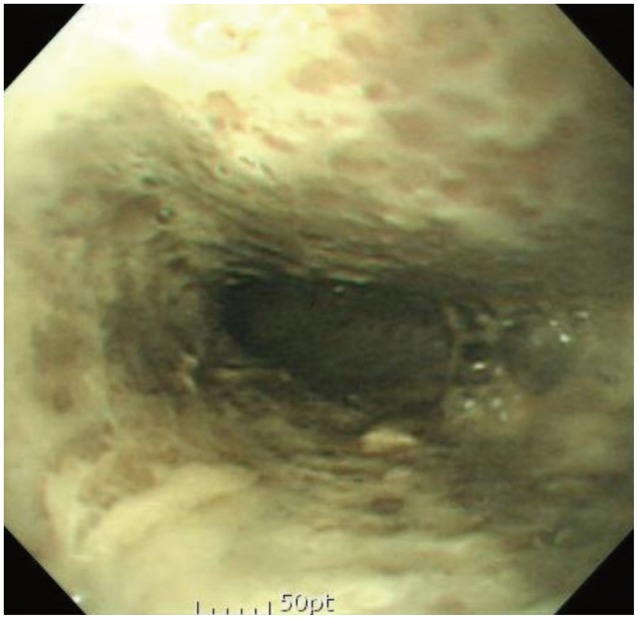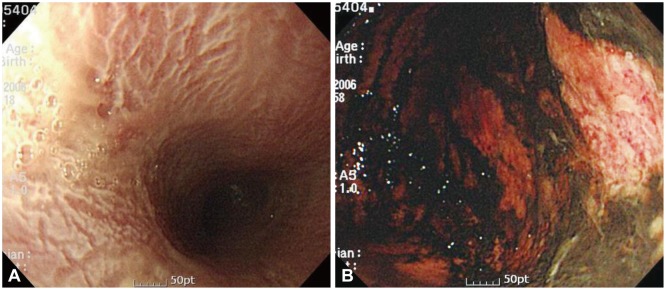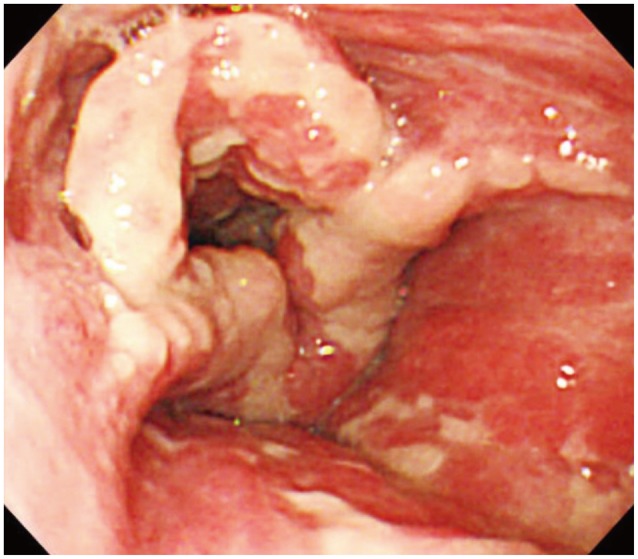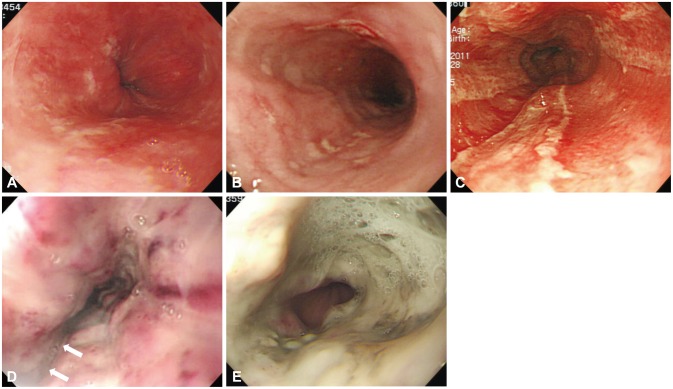Clin Endosc.
2014 Jul;47(4):301-307. 10.5946/ce.2014.47.4.301.
Evaluation and Management of Caustic Injuries from Ingestion of Acid or Alkaline Substances
- Affiliations
-
- 1Department of Internal Medicine, Keimyung University School of Medicine, Daegu, Korea. seenae99@dsmc.or.kr
- KMID: 1907928
- DOI: http://doi.org/10.5946/ce.2014.47.4.301
Abstract
- Although the numbers have decreased compared with in the past, cases of patients who ingest caustic substances and visit the emergency room are not rare. However, well-summarized data about caustic injuries are insufficient. Therefore, in this article, I will discuss the etiologic causative agents, injury mechanism, and clinical characteristics, as well as the endoscopic evaluation of the degree of injury and proper management of the patient, in gastrointestinal caustic injury.
Keyword
Figure
Cited by 3 articles
-
Management of Benign Esophageal Strictures in Children
Yvan Vandenplas
Pediatr Gastroenterol Hepatol Nutr. 2017;20(4):211-215. doi: 10.5223/pghn.2017.20.4.211.Corrosive Esophagitis Induced by Potassium Permanganate
Jin Hee Noh, Kee Don Choi
Korean J Gastroenterol. 2020;75(2):108-111. doi: 10.4166/kjg.2020.75.2.108.Highlights from the 50th Seminar of the Korean Society of Gastrointestinal Endoscopy
Eun Young Kim, Il Ju Choi, Kwang An Kwon, Ji Kon Ryu, Seok Ho Dong, Ki Baik Hahm
Clin Endosc. 2014;47(4):285-294. doi: 10.5946/ce.2014.47.4.285.
Reference
-
1. Goldman LP, Weigert JM. Corrosive substance ingestion: a review. Am J Gastroenterol. 1984; 79:85–90. PMID: 6364797.2. Riffat F, Cheng A. Pediatric caustic ingestion: 50 consecutive cases and a review of the literature. Dis Esophagus. 2009; 22:89–94. PMID: 18847446.
Article3. Gumaste VV, Dave PB. Ingestion of corrosive substances by adults. Am J Gastroenterol. 1992; 87:1–5. PMID: 1728104.4. Yeom HJ, Shim KN, Kim SE, et al. Clinical characteristics and predisposing factors for complication of caustic injury of the upper digestive tract. Korean J Med. 2006; 70:371–377.5. Yoon KW, Park MH, Park GS, et al. A clinical study on the upper gastrointestinal tract injury caused by corrosive agent. Korean J Gastrointest Endosc. 2001; 23:82–87.6. Jung IS, Kim JS. A case of corrosive gastritis caused by salt-fermented Northern Sand Lance. Korean J Gastrointest Endosc. 2011; 42:366–368.7. Joo HR, Park J, Kim TG, Seo EH, et al. A case of corrosive esophagogastritis after copper sulfate ingestion. Korean J Gastrointest Endosc. 2011; 43:30–32.8. Contini S, Scarpignato C. Caustic injury of the upper gastrointestinal tract: a comprehensive review. World J Gastroenterol. 2013; 19:3918–3930. PMID: 23840136.
Article9. Sohn YT, Kim JG, Song DW, Lee SS. Clinical study of corrosive esophagitis. Korean J Otolaryngol-Head Neck Surg. 1992; 35:346–353.10. Wasserman RL, Ginsburg CM. Caustic substance injuries. J Pediatr. 1985; 107:169–174. PMID: 4020540.
Article11. Kim HG, Han KH, Lee SI, et al. A case of corrosive gastritis caused by hydrochloric acid. Korean J Gastrointest Endosc. 1988; 8:19–23.12. Arévalo-Silva C, Eliashar R, Wohlgelernter J, Elidan J, Gross M. Ingestion of caustic substances: a 15-year experience. Laryngoscope. 2006; 116:1422–1426. PMID: 16885747.13. Zargar SA, Kochhar R, Nagi B, Mehta S, Mehta SK. Ingestion of strong corrosive alkalis: spectrum of injury to upper gastrointestinal tract and natural history. Am J Gastroenterol. 1992; 87:337–341. PMID: 1539568.14. Zargar SA, Kochhar R, Mehta S, Mehta SK. The role of fiberoptic endoscopy in the management of corrosive ingestion and modified endoscopic classification of burns. Gastrointest Endosc. 1991; 37:165–169. PMID: 2032601.15. Fisher RA, Eckhauser ML, Radivoyevitch M. Acid ingestion in an experimental model. Surg Gynecol Obstet. 1985; 161:91–99. PMID: 4012549.16. Poley JW, Steyerberg EW, Kuipers EJ, et al. Ingestion of acid and alkaline agents: outcome and prognostic value of early upper endoscopy. Gastrointest Endosc. 2004; 60:372–377. PMID: 15332026.
Article17. Gaudreault P, Parent M, McGuigan MA, Chicoine L, Lovejoy FH Jr. Predictability of esophageal injury from signs and symptoms: a study of caustic ingestion in 378 children. Pediatrics. 1983; 71:767–770. PMID: 6835760.
Article18. Salzman M, O'Malley RN. Updates on the evaluation and management of caustic exposures. Emerg Med Clin North Am. 2007; 25:459–476. PMID: 17482028.
Article19. Hoffman RS, Howland MA, Kamerow HN, Goldfrank LR. Comparison of titratable acid/alkaline reserve and pH in potentially caustic household products. J Toxicol Clin Toxicol. 1989; 27:241–246. PMID: 2600988.
Article20. Rigo GP, Camellini L, Azzolini F, et al. What is the utility of selected clinical and endoscopic parameters in predicting the risk of death after caustic ingestion? Endoscopy. 2002; 34:304–310. PMID: 11932786.
Article21. Cheng YJ, Kao EL. Arterial blood gas analysis in acute caustic ingestion injuries. Surg Today. 2003; 33:483–485. PMID: 14506990.
Article22. Katzka DA. Caustic injury to the esophagus. Curr Treat Options Gastroenterol. 2001; 4:59–66. PMID: 11177682.
Article23. Celik B, Nadir A, Sahin E, Kaptanoglu M. Is esophagoscopy necessary for corrosive ingestion in adults? Dis Esophagus. 2009; 22:638–641. PMID: 19515187.
Article24. Previtera C, Giusti F, Guglielmi M. Predictive value of visible lesions (cheeks, lips, oropharynx) in suspected caustic ingestion: may endoscopy reasonably be omitted in completely negative pediatric patients? Pediatr Emerg Care. 1990; 6:176–178. PMID: 2216918.25. Cabral C, Chirica M, de Chaisemartin C, et al. Caustic injuries of the upper digestive tract: a population observational study. Surg Endosc. 2012; 26:214–221. PMID: 21858575.
Article26. Aronow SP, Aronow HD, Blanchard T, Czinn S, Chelimsky G. Hair relaxers: a benign caustic ingestion? J Pediatr Gastroenterol Nutr. 2003; 36:120–125. PMID: 12500007.
Article27. Chirica M, Resche-Rigon M, Bongrand NM, et al. Surgery for caustic injuries of the upper gastrointestinal tract. Ann Surg. 2012; 256:994–1001. PMID: 22824850.
Article28. Chiu HM, Lin JT, Huang SP, Chen CH, Yang CS, Wang HP. Prediction of bleeding and stricture formation after corrosive ingestion by EUS concurrent with upper endoscopy. Gastrointest Endosc. 2004; 60:827–833. PMID: 15557970.
Article29. Kamijo Y, Kondo I, Kokuto M, Kataoka Y, Soma K. Miniprobe ultrasonography for determining prognosis in corrosive esophagitis. Am J Gastroenterol. 2004; 99:851–854. PMID: 15128349.
Article30. Ryu HH, Jeung KW, Lee BK, et al. Caustic injury: can CT grading system enable prediction of esophageal stricture? Clin Toxicol (Phila). 2010; 48:137–142. PMID: 20199130.
Article31. Cakal B, Akbal E, Köklü S, Babali A, Koçak E, Taş A. Acute therapy with intravenous omeprazole on caustic esophageal injury: a prospective case series. Dis Esophagus. 2013; 26:22–26. PMID: 22332893.32. Bothereau H, Munoz-Bongrand N, Lambert B, Montemagno S, Cattan P, Sarfati E. Esophageal reconstruction after caustic injury: is there still a place for right coloplasty? Am J Surg. 2007; 193:660–664. PMID: 17512272.
Article33. Zhou JH, Jiang YG, Wang RW, et al. Management of corrosive esophageal burns in 149 cases. J Thorac Cardiovasc Surg. 2005; 130:449–455. PMID: 16077412.
Article34. Fulton JA, Hoffman RS. Steroids in second degree caustic burns of the esophagus: a systematic pooled analysis of fifty years of human data: 1956-2006. Clin Toxicol (Phila). 2007; 45:402–408. PMID: 17486482.
Article35. Anderson KD, Rouse TM, Randolph JG. A controlled trial of corticosteroids in children with corrosive injury of the esophagus. N Engl J Med. 1990; 323:637–640. PMID: 2200966.
Article36. Siersema PD, de Wijkerslooth LR. Dilation of refractory benign esophageal strictures. Gastrointest Endosc. 2009; 70:1000–1012. PMID: 19879408.
Article37. Krey H. On the treatment of corrosive lesions in the oesophagus; an experimental study. Acta Otolaryngol Suppl. 1952; 102:1–49. PMID: 14932984.38. Kochhar R, Poornachandra KS, Puri P, et al. Comparative evaluation of nasoenteral feeding and jejunostomy feeding in acute corrosive injury: a retrospective analysis. Gastrointest Endosc. 2009; 70:874–880. PMID: 19573868.
Article39. Berger M, Ure B, Lacher M. Mitomycin C in the therapy of recurrent esophageal strictures: hype or hope? Eur J Pediatr Surg. 2012; 22:109–116. PMID: 22517516.
Article40. Uhlen S, Fayoux P, Vachin F, et al. Mitomycin C: an alternative conservative treatment for refractory esophageal stricture in children? Endoscopy. 2006; 38:404–407. PMID: 16586239.
Article41. De Peppo F, Zaccara A, Dall'Oglio L, et al. Stenting for caustic strictures: esophageal replacement replaced. J Pediatr Surg. 1998; 33:54–57. PMID: 9473100.
Article42. Broto J, Asensio M, Vernet JM. Results of a new technique in the treatment of severe esophageal stenosis in children: poliflex stents. J Pediatr Gastroenterol Nutr. 2003; 37:203–206. PMID: 12883312.
Article43. Lee SI, Shn SH, Park IS, Choi HJ. Dilatation of severe corrosive esophageal stricture guided by right coronary artery catheter. Korean J Gastrointest Endosc. 1991; 11:77–80.44. Lee MS, Kim JW, Kim JH, Cho SW, Shim CS. Non-operative dilatation of corrosive esophageal and gastric angular stricture: a case report. Korean J Gastrointest Endosc. 1989; 9:151–155.
- Full Text Links
- Actions
-
Cited
- CITED
-
- Close
- Share
- Similar articles
-
- Prediction of Systemic Complications from Caustics Ingestion Through Arterial Blood Gas Analysis
- The Clinical Characteristics and Risk Factors of Upper Digestive Lesions that are due to Ingestion of Caustic Material
- Computed Tomography Grading for Predicting Esophageal Stricture in Caustic Injury
- Intercontinental comparison of caustic ingestion in children
- Hematological Parameters Predicting Complications of Caustic Ingestion: A Retrospective Study





